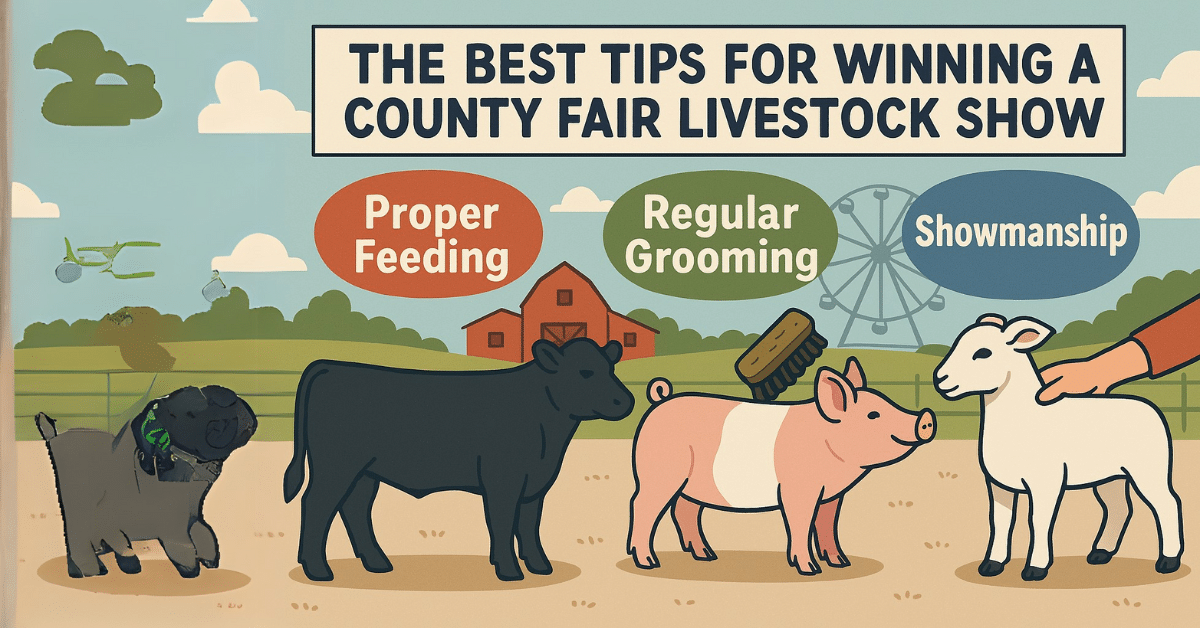Participating in a county fair livestock show is more than just walking an animal around a ring — it’s a test of commitment, preparation, and knowledge. For many, especially youth in 4-H and FFA, these shows are a chance to apply months of work and care into a few important minutes in front of a judge. Winning isn’t just about having the best animal on the day; it’s about the preparation leading up to the event, the bond between exhibitor and animal, and the small details that often make a big difference.
The Best Tips for Winning a County Fair Livestock Show
Whether you’re raising cattle, pigs, goats, or lambs, the tips below will help you prepare with confidence and aim for the top spot in your next livestock competition.
Choose the Right Animal from the Start
Success at the fair often begins long before show day — with the selection of your animal. This decision can set the tone for your entire season. While every animal has potential, starting with a strong foundation gives you a better chance at producing a champion.
When selecting your animal, consider the following:
- Conformation: Look for balanced structure, straight lines, and good muscle development.
- Temperament: An animal with a calm, trainable personality will be easier to work with.
- Age and Weight Class: Make sure your animal fits within the ideal age or weight range for your target show.
- Health Status: Always choose an animal that is alert, active, and free from visible signs of illness or injury.
Building a relationship with trusted breeders or visiting reputable farms can help you evaluate multiple animals and make the most informed choice.
Focus on Daily Nutrition and Consistent Feeding
Feeding is not a one-size-fits-all routine — every species, breed, and individual animal has slightly different needs. A proper nutrition program helps develop muscle tone, maintain energy levels, and support overall health.
Key feeding principles:
- Balanced Diet: Include a mix of grains, proteins, fiber, and minerals.
- Clean Water: Ensure fresh water is always available, especially during hot weather.
- Consistent Schedule: Feed your animal at the same times each day to develop a routine.
- Monitor Intake: Track how much your animal eats and how it responds to any dietary changes.
Some exhibitors also work with livestock nutritionists or use show-specific feed blends tailored for peak physical condition.
Train Early and Often for Calm, Show-Ready Behavior
One of the most common reasons even good animals lose in the show ring is lack of training. Show animals must be comfortable with noise, people, new environments, and physical handling. This takes time, repetition, and patience.
Start halter training or pen walking as early as possible. Practice in short, calm sessions and gradually introduce distractions. Encourage trust and reward cooperative behavior.
Here’s a simple checklist for building ring readiness:
- Practice leading and stopping on command
- Teach animals to stand still and be touched
- Get them used to show sticks or combs
- Simulate ring noise and activity
- Walk on different surfaces and environments
By the time fair week arrives, your animal should feel comfortable with you and confident in a variety of situations.
Perfect Your Showmanship Skills
Even if your animal isn’t perfect, strong showmanship can still earn you a place on the judge’s radar. Showmanship is about how well you present your animal, how attentive you are, and how you handle unexpected situations.
Good showmanship includes:
- Maintaining eye contact with the judge
- Keeping your animal between you and the judge at all times
- Always being aware of your animal’s posture and movement
- Using your tools subtly and professionally
- Being courteous to other exhibitors
Practice in front of mirrors, or better yet, have someone record you while practicing. Watch your performance and make adjustments.
Grooming and Presentation Matter
Livestock that are well-groomed and clean not only look better but also show respect for the competition. Grooming isn’t just about appearance — it’s about health and comfort too.
Each species has its own grooming routine. For example:
- Cattle: Regular brushing, washing, and fitting (clipping or blowing hair for shape)
- Lambs: Slick shearing with proper blade techniques
- Pigs: Gentle washing, oiling to highlight skin, and clean hooves
- Goats: Clipping for shape and washing to remove stains
A week before the show, develop a grooming schedule to help avoid last-minute stress. Prepare your grooming kit, trim hooves, and double-check for any skin issues or sores.
the Rules and Scorecards
Each county fair has its own set of rules — from animal eligibility to how classes are divided and judged. Reviewing these details can prevent disqualifications and give you a better idea of how to stand out.
You should:
- Read the exhibitor’s guidebook thoroughly
- Know species-specific scorecards and judging criteria
- Pay attention to things like weight limits, tag requirements, and deadlines
- Understand how classes are split (by age, breed, weight, etc.)
Judges typically evaluate both animal quality and how well they’re handled. The more you know about what they’re looking for, the more you can prepare accordingly.
Practice Mock Shows Before the Big Day
One of the best ways to build confidence is through repetition in a realistic setting. Create mock show scenarios at home with friends, mentors, or family members acting as judges. Include walk-in and exit routines, questions from judges, and simulated distractions.
This is especially helpful for younger exhibitors, helping them stay composed under pressure and adapt to unexpected situations in the ring.
Show Up Prepared (and Early) on Show Day
Being organized on show day helps things run smoothly and keeps both you and your animal calm. Have everything you need packed and ready the night before.
Bring essentials like:
- Halters, leads, show sticks
- Feed, water buckets, and snacks
- Registration papers and health records
- Brushes, towels, spray bottles
- Emergency items (first aid kit, duct tape, scissors)
Arrive early to allow plenty of time for unloading, check-in, and last-minute grooming. Stick to your feeding schedule and walk your animal around the grounds to help them adjust.
Learn from Every Experience
Even if you don’t take home the top prize, every show is a learning opportunity. Listen to feedback from judges, talk to other exhibitors, and take mental notes on what worked — and what didn’t.
Consider keeping a show journal where you record:
- Animal condition and behavior
- Judge’s comments
- Class placements
- Things to improve next time
Winning consistently takes time, and improvement is a gradual process. Celebrate small wins and stay committed.
Final Thoughts
County fair livestock shows are more than a competition — they’re a celebration of care, discipline, and personal growth. Preparing for the ring is a season-long journey that requires attention to detail, consistent effort, and a love for animals.
By starting early, sticking to a routine, and learning from each experience, you’re setting yourself up not just for success at the fair, but for skills that will stay with you for life.
So polish those boots, groom your animals, and head into the ring ready to give it your best.







Leave A Comment